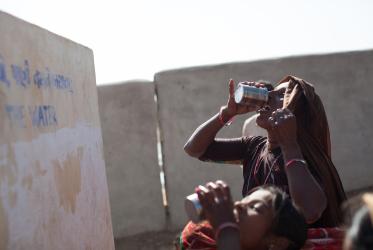Come, all you who are thirsty, come to the waters; and you who have no money, come, buy and eat!... Listen, listen to me, and eat what is good.” (Isaiah 55:1-2)
Over the coming decades, feeding a growing global population and ensuring food and nutrition security for all will depend on increasing food production. This, in turn, means ensuring the sustainable use of our most critical finite source, water. (Ban Ki-moon, former UN Secretary-General)
As the world begins the countdown to the 24th World Water Day celebration on 22 March 2017, with the theme, “Wastewater”, the ever-recurring issue of the importance of the availability of water for food security comes to the fore. Interestingly, World Water Day in 2012 focused on the theme of “Water and Food Security”. World Water Day is set aside to refocus attention on the importance of water and the international day to celebrate freshwater was recommended at the 1992 United Nations Conference on Environment and Development (UNCED). The United Nations General Assembly chose 22 March, 1993 as the first World Water Day.
It is an understatement to state that water availability, as the world should know it, is not a reality in many places. The Nigerian example is a major pointer to the lack of availability of water and how it affects food security.
Plants need water to grow; animals also need water to survive and it is from these, that much, if not all, of the word’s food is derived. Recent herdsmen’s clashes in Nigeria pinpoint how the unavailability of water can wreak havoc on food production.
Due to the arid nature of their original homeland, and the increased drying up of water sources, the herders are forced to move down south for water and the consequences are there for all to see. In the search for water sources, farmlands are destroyed by cattle, resulting in meagre yields, which, in turn, contribute in no small measure to increased hunger on the land.
According to the November 1996 World Food Summit, food security is achieved “when all people, at all times, have physical, social and economic access to sufficient, safe and nutritious food to meet dietary needs for a productive and healthy life.” The issue of accessibility to potable water and its effect on guaranteeing food security is also evident in weather conditions and how these affect the availability of quality farm produce as well as the cost of food items.
Take for instance, rice, which can more or less, be regarded as Nigeria’s staple food. Rice needs much water to grow and of its lack of availability in many areas means the country has to rely, to a large percentage, on importation, which affects the market price, which is further impacted by the unstable foreign exchange rate.
The Global Water Partnership states, “In most countries, and with no improvements in land and water productivity, water demand for agriculture is expected to increase more than the current levels of 70 per cent. The demand for more food will continue to increase not only because of population growth, but as a result of increased incomes and changing consumption patterns that are geared towards consumption of meat and other animal products. More frequent and severe droughts and floods are already apparent in many regions and this is impacting on the extent and productivity of both irrigated and rain-fed agriculture across the globe; food production relies heavily on water, however, and other factors such as the right governance frameworks, improved seeds and inputs, post-harvest handling, energy and policies (agricultural subsidies and trade policies) all play a critical role in achieving food security.”
Roughly one third of the food produced in the world for human consumption every year — approximately 1.3 billion tonnes — gets lost or wasted. If we can prevent food waste, we do not need to produce that 30-40% of food which is going to be wasted and thereby can save that amount of fresh water, which goes into producing the food.
In 1948, the Universal Declaration of Human Rights affirmed the right of all people to adequate food. However, access to adequate food in the rural areas of many developing countries depends heavily on access to natural resources, including water, that are necessary to produce food. The UN General Assembly declared access to clean drinking water and sanitation as a human right on 28 July 2010. But the right to water in the context of the right to food is a complex question. While drinking and cooking water would be protected, water for food production would probably not be covered under the minimum needs in arid areas.
The UN provides recommendations for ensuring the availability of water and ensuring food security, which is highlighted below:
- To produce more nutritious food with less water, innovative technologies are required to ensure greener and more sustainable food production. They are needed to improve crop yields; implement efficient irrigation strategies; reuse of drainage water and use of water resources of marginal quality; produce smarter ways to use fertilizer and water; improve crop protection; reduce post-harvest losses; and create more sustainable livestock and marine production.
- Agricultural development in the least developing countries (LDCs) lies mainly in the hands of smallholders, a large majority of whom are women. Therefore, new institutional arrangements are needed that centralize the responsibility for water regulation, yet decentralize water management responsibility and increase user ownership and participation.
- To improve the value chain: From production, post-harvest handling, processing, retailing, consumption to distribution and trade, efficient water and food recycling strategies can be addressed. It can help secure environmental water requirements when reuse of treated water is not culturally acceptable for other uses.
Virtual water is "the volume of freshwater used to produce the product, measured at the place where the product was actually produced".[1] It refers to the sum of the water use in the various steps of the production chain. Virtual water trade (also known as trade in embedded or embodied water) refers to the hidden flow of water if food or other commodities are traded from one place to another. The precise volume can be more or less depending on climatic conditions and agricultural practices. It is hard to believe that a cup of coffee has 125 litres of “virtual water” in it, a hamburger has 2,500 litres, a kilo of chicken has about 3,700 litres, a kilo of beef about 15,500 litres and so on, whereas a kilo of potatoes has only 500 litres of virtual water. Therefore, it is always advisable to eat a vegetarian diet and if possible, eat locally grown food, which has a lower water footprint in terms of importing food across continents.
We are reminded by the prophet Isaiah, who asserts that water should be affordable for all, and that for those who cannot afford it, it should be available at no cost. He also reminds us to eat what is good! The above facts might help us to choose wisely what we eat!
Resources:




